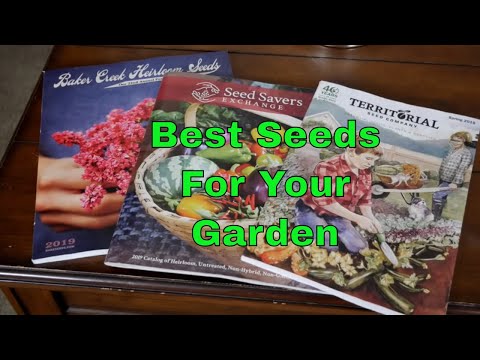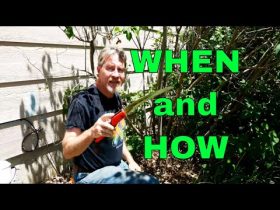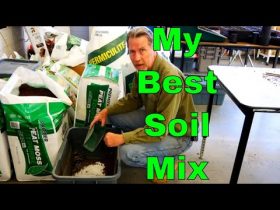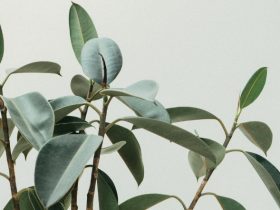In January, it’s cold outside, and it’s snowing. It’s not a good outside gardening day, but I think it’s a good inside gardening day. I’m about to move inside and start looking through my seed catalogs. So join me as I choose my garden seeds. It’s cold snowy days like this that really give me great opportunity to start thinking about what the garden will look like when all the snow is gone and I can be outside in the sun, growing the plants.
I have ideas about what I want to grow and every year it seems to change. So it’s a day like today that I can really start the process and start choosing the seeds that I will grow this year. While I thoroughly enjoy the process it can be a bit frustrating because as I start to look through the seed catalogs I want everything.
Every page I look to there’s something I want. I flick to another page and there’s something I want, and I go to another page and there’s something I want and I’ve actually had years where I spent way too much on seeds and bought way more than I could possibly plant. So I’ve come up with some basic guidelines that I use every year and that I encourage you to use as well, to help avoid some of that frustration and really focus on choosing the seeds that are best for you and your garden.
The first thing to do is decide what you want to grow. Now I know that sounds relatively simplistic, but many gardeners just grow the same things year after year and so choosing the seed is pretty easy, but if you want to stretch the limits a little bit and learn more about gardening and about yourself in your garden, start a list of what this year’s garden will look like.
How it will be different from last year’s garden. The list doesn’t need to be specific at this point, as far as which varieties you’re going to grow. If you want to grow tomatoes, just write “tomatoes” and leave it at that. You don’t need to specify exactly which varieties you want to grow.
That’ll come later as you actually start looking at the sources of where the seeds will come from. Just write down “carrots” or “tomatoes” or “peppers” or “squash”. You can be general at this stage. The way I do it is with a pad of paper. Now, you could do it on a computer, a tablet, your phone.
Whatever works best for you,. But I start by identifying the things that worked well last year and then decide if I want to repeat those plants. I had a really good year with spaghetti squash and butternut squash. So my list includes spaghetti squash and butternut squash again this year, but I think I’m going to stretch it a little bit more.
I think I’m gonna start growing some squashes that I’ve never grown before because I’ve kind of figured out how to do the butternut and the spaghetti squashes. So I’m writing down “squash”. I don’t really know what that means yet. When I start looking through the catalogs.
I’ll get some ideas to narrow it down, but squash is on the list. Tomatoes and cucumbers are always a part of my garden, but I’ve been doing a lot more fermenting in recent years and last year I didn’t grow any pickling cucumbers. I definitely want to grow pickling cucumbers this year. So pickling cucumbers has made the list.
“Herbs”. I’ve got a lot of perennial herbs that are growing in my garden but there’s some annual herbs that I want to start growing as well and so annual herbs are on the list. And I’ll keep doing this, identifying the plants that I’ve grown before and want to repeat, the plants that I’ve never grown before and want to try something new, and as I go through it, I’ll leave some spaces for maybe some things that I haven’t figured out yet.
But I can add to the list as I go through the seed catalogs. If you’re anything like me your list is getting longer and longer because there’s just so many plants that I want to grow. That’s okay because this first step is a lot like brainstorming, where you just write down anything that comes to mind.
You’re just listing all those things that you want to grow. Doesn’t necessarily mean that you will be growing them. You’re just starting the list. And that takes us to the second step, which is to make a garden plan. Now you’ve probably seen books and maybe other videos that say the first step should be make a garden plan, but I think you need to have an idea of what you’re going to do in your garden before you start planning your garden and once you have a long list, now you can actually look at your garden space.
You can look at the number of beds you have, you can look at the number of pots you have, you can think about how maybe you might be expanding your garden this year and you’ve got some ideas of specific plants to put into those spaces. So draw out your garden. It doesn’t have to be perfect.
Just general ideas of… I have a 4 foot by 8 foot bed, and in this bed I will be able to fit 20 plants. Well what 20 plants are you going to choose ? You now have a list of those plants. So maybe I’ll put a couple of my squashes in that bed and maybe I’ll put some peas in that bed. That’s the idea.
Just start developing an idea, a general plan for where you think you’re going to put some of these plants in your garden and what you’re going to find is probably a lot of them aren’t going to fit. But it’s okay if the plants don’t fit. It gives you an opportunity to prioritize.
Instead of growing 15 tomato plants, maybe you only grow 12 tomato plants because you want to fit in a couple tomatillos that you want to grow this year. So that’s where the garden plan comes in and that’s how you fit what you want to grow into your garden plan, is you add and subtract and eventually, you try to make things fit the best way you can.
When you begin to feel comfortable with your garden plan and you fit in the things that you want to grow, now you can move to the next step which is to decide how many seeds you need. Some of its easy, You want to grow a handful of squash, you need a handful of squash seeds. If you want to grow 15 tomato plants you need to stop for a second and think, how many of those are coming from seed? How many tomato plants are you going to start from seed? If you’re planning to purchase most of the tomatoes as plants to put in your garden, well, then maybe you really only need just a few tomato seeds if you’re gonna be starting inside, or maybe no tomato seeds at all.
So go through the list, look at your garden plan, and start quantifying the specifics of how many seeds you need for each of the things that you’re planning to grow. Your long list of plants that you want to grow in your garden may end up being not as many seeds as you think. When you’re feeling pretty good about your list of plants you want to grow and your garden plan, now you’re ready for the next step, which is to Look through the seeds that you already have, and I admit this is a step that I have left out in years past.
Which is why I often end up with so many extra seed packets. I just keep buying the same ones because I didn’t look to see what I already have. So this year… Hey, I want to grow Swiss chard and I’ve got a package of Swiss chard seeds. I don’t need to buy those. Here’s some spaghetti squash.
Here’s some butternut squash. This is looking pretty good. I wanted some annual herbs. Oh, here’s a dark opal basil. That would be great to grow. I’m gonna go ahead and put that on the garden plan in one of those spaces I was unsure about. Here’s an heirloom tomato that definitely fits with my plan.
I can’t find it at a nursery, so I’ll have to start it from seed. Here’s an onion seed and I want to grow onions, but onions are notoriously terrible as to keeping their viability after more than about a year, so even though I have an onion seed package, I think I’m gonna go ahead and have to buy some more onion seeds.
Here’s some squash. Hey, It’s a pickling cucumber. Just by looking through my seed packets, I’ve already reduced the number of seeds that I’m going to have to buy because I already have a number of them in my box from last year. And don’t forget all the seeds that you collected from your garden.
I collected a whole bunch of purple carrot seeds last year with the intention of growing a whole bunch of purple carrots this year. So I don’t need to buy those carrots anymore. I saved cilantro seeds. I saved my rattlesnake bean seeds. I saved some very special tomato seeds. Those are all plants that are part of my plan for this year.
And I don’t need to worry about purchasing any of those packets because I collected the seed myself. All of the previous steps should leave you with a pretty good idea of what seeds you need to fill out your garden plan and that leads us to my favorite step, which is to actually look through the seed catalogs.
I read a lot of comic books when I was a kid and though I’m much older now I get the same enjoyment through the seed catalogs, looking at the colorful pictures, reading the amazing descriptions, and imagining what they’ll look like in my garden. One of the reasons that I like this step so much is because this is the point where you specifically identify the exact plants that you’ll be growing in your garden.
By looking through the catalogs, you can look at the different varieties, the different types of plant, and choose what you’re going to purchase. My garden plan calls for onions. So I’ve been looking at the different onions that Territorial Seed offers and here’s one called Red Torpedo. it fits with my garden plan, it fits with the region that I grow in, and it might be perfect and it brings me back to that youthful period of reading comic books because red torpedo sounds like a superhero.
And what could be better than putting a superhero in your garden? This is fun. Today I’m beginning with three of my favorite seed catalogs: Territorial Seed Company is just packed with wonderful ideas. Now this is where I get myself into trouble because I look through it and I come across something that wasn’t part of my garden plan, like sweet potatoes.
I wasn’t planning on growing sweet potatoes, but I’m beginning to second guess myself. Which is why those first steps are so important. You really do need to have an idea of what you want to grow and the seeds that you need because you can easily be led astray. I did say I left some space for things to add or to change my mind.
Enjoy the pictures, enjoy the possibility of what they could look like in your garden, but really do try to stick to your plan. Another catalog I’m looking through today is one from Seed Savers Exchange an organization that I really try to support, and I’m really impressed with and they too have some wonderful pictures with wonderful descriptions of plants that I’d love to have in my garden.
The third catalog is my favorite. It’s Baker Creek Heirloom Seeds. I love growing heirlooms. And I love the stories. I love the descriptions. I love everything about this catalog. They have things that I’ve never heard of before and every year they seem to add new ones. Here’s a black sweet corn.
I look at this and I think I have to grow it in my garden, but my plan doesn’t allow for growing a lot of corn. So even though I’d love to grow this black sweet corn it’s not going to happen this year. So I’ll read the descriptions, I’ll enjoy the pictures, and I’ll move on trying to focus on the things that were part of my plan.
This part of the process, it takes a while. Enjoy it. Enjoy the pictures. Enjoy the descriptions. Enjoy learning something new through these catalogs. And when you come across something that’s on your list, circle it or dog-ear the page, just do something to identify that you found it in one of these catalogs so that you can come back and make a decision.
Now I am focusing on seed catalogs for this step because I get so much enjoyment out of it, but if you’re not looking for a lot of different types of seeds, maybe your garden is smaller, or maybe you already have many seeds and are just looking for a few packets. You can choose another option. Instead of seed catalogs, go to your local garden center or to a nursery and do the same thing.
Look through the different seed packets that are offered and see what fits with your garden plan. After you’ve gone through the seed catalogs at least once just to enjoy them, now you’re ready for the next step, which is to compare prices, and yes, this takes me a while because I do go cover to cover looking at all the possibilities.
But what you’ll find is that most of these catalogs carry pretty much the same types of seeds. Remember I said I was going to grow butternut squash? Well all three of these catalogs carry butternut squash. So Territorial Seed has the Waltham butternut. They sell three grams for two dollars and 85 cents.
This wonderful Seed Savers Exchange also has the Waltham butternut squash. They sell a seed packet, which is about 25 seeds, for three dollars and 25 cents. And of course Baker Creek, they carry the Waltham butternut as well. They have a packet for two dollars and fifty cents and their packets are 20 to 35 seeds.
So as I compare these I’ll see in this first go-round that Baker Creek really saves me a little bit of money because I’m not looking for a lot of seeds. Did you catch what almost happened there? I want to grow butternut squash, I found butternut squash in all three catalogs. I was comparing the prices of the butternut squash and I was thinking about which one to purchase, but when I checked the seeds that I already have, I have a package of butternut squash.
So don’t forget all of those previous steps as you get wrapped up in looking at the catalogs. Because this is where I’ve got myself into trouble is by buying things that I already had, forgetting that, I had already known that I had it. And do give yourself the permission to go outside your plan, to go outside your list a little bit.
Remember I said I was leaving some space to try some new squash? Well, here’s one called Sunburst, which is a scallopini squash. I’ve never grown this before and so it’s something that I definitely want to try this year. I left room for it in the plan. I left a space on my list and I think this might be the one to fill that space and as I look through the different catalogs, when I have those extra spaces to fill, I can be a little creative.
I can try something new, but ultimately I am trying to identify which company offers the best price for the seeds that I need. As you’ve probably figured out, I really enjoy the old school pleasure of thumbing through seed catalogs. But also as part of this step I don’t just rely on these paper catalogs.
This just gives me a real good way to compare three catalogs, side-by-side. After I’ve identified the ones that I want and the companies that will provide them, then I go online, because online you might find some offers that aren’t identified in the catalogs and you might actually see something else that’s comparable, to save a few dollars.
I also look at the shipping rates as part of this step because even though some of these companies might have cheaper prices for their seeds, they might have more expensive prices for the shipping and there’s actually been some companies where I’ve changed my mind, because the shipping costs were so high and a different catalog was offering free shipping.
So ultimately I could pay more for the seeds because I’m paying less for shipping. I save money overall. I have focused on saving money if you follow the steps of this process because you’re not buying seeds that you really don’t need and because you’re comparing prices to try to buy the most inexpensive seed, but there is another factor when you look through the seed catalogs and compare the prices, and that’s to think about what the company is and that’s why I chose these three catalogs specifically, because I really believe in these companies and what they’re trying to do for our gardening community.
Territorial Seed runs trials and offers plants that you really can’t find anyplace else. Baker Creek is a family-run operation that focuses on heirloom seeds, that have a long history and a heritage to them, that is really kind of fun to follow. Seed Savers Exchange follows that same basic idea where they try to keep varieties of seeds from disappearing because they offer it to us in their catalog so we can continue to grow plants that have been grown for decades and generations.
I really like these companies. They do offer some unique offerings. The things that are common to all of them you can probably find in other catalogs or online for less, but I always try to order from at least these three just because it helps me support a concept, a philosophy that I think is important in our gardening community.
And now you’re ready for the final step, which is to order the seeds that you’ve chosen. It’s a simple process of going to the online site of the company that you’ve chosen to order from and just doing it like any other online order. Now I am assuming that you do have some seed catalogs to thumb through.
If you don’t, I do have another video that you can check out that tells the truth about seed catalogs, from my viewpoint, and gives many links to many of my favorite catalogs, or you can bypass the paper catalog completely and just do all of your comparison and all of your ordering online. I do like to take my time with all the steps of this process.
So it takes a few days from the beginning of the list to the time that I choose to order and there’s really no rush, which is why it’s a perfect winter snowy day activity and I’ll spend hours, maybe with a glass of wine, perusing the catalogs before I make my final decision. And there you have it.









Leave a Reply